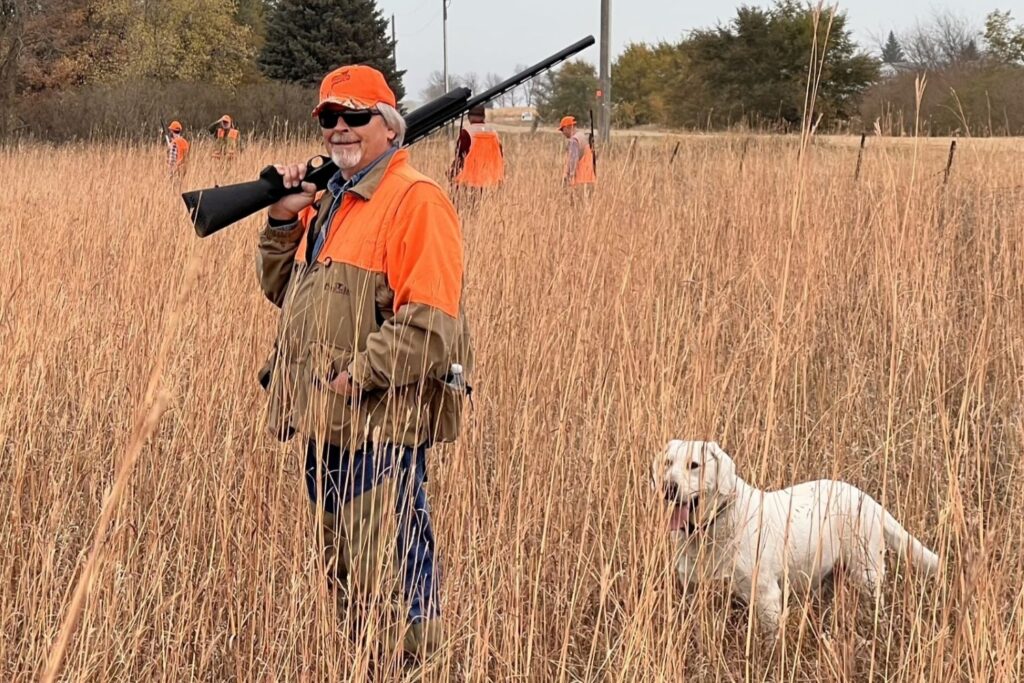Brad Johnson hunts for pheasants with his dog, Frisco, on Conservation Reserve Program land near Brookings in 2024. (Courtesy of Brad Johnson)
It’s harvest time in South Dakota and for nearly 140,000 pheasant hunters, it is an opportunity to wander fields of grass, edges of wetlands and pockets of overgrown weeds.
All across the state, farmers are growing and selling corn, wheat, soybeans, cattle and other products, contributing billions of dollars to the state’s economy.
Hunters this fall will likely harvest more than 1.3 million pheasants, 47,000 deer, 220,000 ducks, and 300,000 geese in South Dakota, along with antelope, elk, grouse, turkey, rabbits and other wildlife. Our beautiful landscape and abundant wildlife provide a huge boon to local communities as hunters fill hotel rooms and restaurants.
These twin economic pillars — farming and tourism — both benefit greatly from the federal farm bill and its voluntary, incentive-based conservation programs. These programs provide farmers with funds and advice needed to put in place much-needed systems that conserve our soil, water and wildlife.
Thune files bipartisan bill to strengthen federal conservation program
In South Dakota, about 80% of the land is privately owned, which means the vast majority of sportsmen and women are hunting in habitat on private lands.
Most landowners want to be good stewards, but many do not have resources to create or restore wildlife habitat. Through the farm bill, the U.S. Department of Agriculture can help provide those resources.
In July, Congress extended four major farm bill conservation programs, and in a big win for wildlife, increased the long-term funding for the programs by about 50%.
Congress also extended some smaller programs like the Voluntary Public Access & Habitat Incentives Program that has supported our state’s Walk-in Area Program, which provides hunting access on more than 1.25 million acres.
Unfortunately, the Conservation Reserve Program — which turns 40 years old this year — was the one major farm bill conservation program that did not get extended in July. It and many other farm bill programs expired on Sept. 30.
Until Congress finishes the work to write a new farm bill or extends the current one, USDA will be unable to enroll any new acres in CRP contracts. CRP is a popular and effective tool that helps farmers protect existing grassland or plant marginal cropland with grasses, shrubs and trees. The program has three major purposes: soil conservation, wildlife habitat and water quality.
According to a March 2024 report on pheasant management by the state Department of Game, Fish and Parks, “the CRP represents one of the most successful conservation programs ever implemented in the United States.”
To complicate matters, when Congress failed to pass a funding bill before Oct. 1 and the government shut down, USDA sent 96% of its conservation employees home and closed offices around the country.
USDA even stopped issuing checks, like the annual CRP payments to landowners that were supposed to go out Oct. 1. USDA has already lost nearly one-quarter of its conservation staff since the new administration took over in January, and the government shutdown will put USDA employees even further behind and make life more difficult for farmers.
South Dakota’s hunters, anglers, farmers and ranchers are some of the top beneficiaries of CRP in the country, with over 2.6 million acres enrolled in the program. CRP contracts bring over $145 million annually to more than 14,000 South Dakota landowners. That doesn’t include the myriad other benefits from the program, like the boost in the outdoor economy that comes from the wildlife produced on those lands.
Over 542,000 acres of CRP contracts in South Dakota are wetlands, providing nesting and migratory habitat for ducks, geese and other waterfowl. The U.S. Fish and Wildlife Service estimates CRP acres in the northern Great Plains add about 2 million ducks to the fall flight every year.
Despite the popularity and success of CRP, Congress is considering proposals that would reduce the program’s benefits for producers, outdoors enthusiasts and wildlife. The program doesn’t need a major overhaul. It just needs a few common-sense improvements.
Thankfully, Senate Majority Leader John Thune, R-South Dakota, and Senators Amy Klobuchar, D-Minnesota, Jerry Moran, R-Kansas, and Tina Smith, D-Minnesota, recognize the benefits of the program and its value. They introduced the Conservation Reserve Improvement and Flexibility Act, which would add to the program’s ability to meet producer needs.
The bill would streamline the application process for CRP State Acres for Wildlife Enhancement, an increasingly popular option in South Dakota where over 235,000 acres are planted to grass species that benefit pheasants and other grassland birds.
Their bill would provide federal payments for fencing and water facilities to encourage sounder grazing of CRP acres and would increase the annual limit on CRP payments that has not been raised since CRP was created in 1985.
The CRP Transition Incentives Program has already helped more than 2,900 farmers acquire over 400,000 acres of expiring CRP land nationwide, but the program could do even more to help new and beginning farmers if Congress would prioritize them in awarding new CRP contracts as it now does for other USDA conservation programs. With some minor changes, CRP could also be a stronger tool for establishing and maintaining migratory corridors for wildlife.
As members of Congress consider these and other changes to the program, they should ensure there are no cuts. We need more CRP acres, not less.


